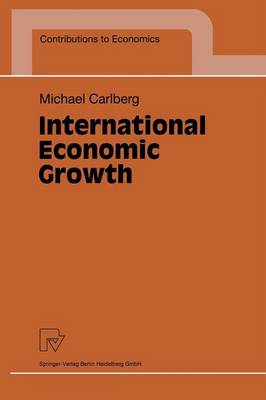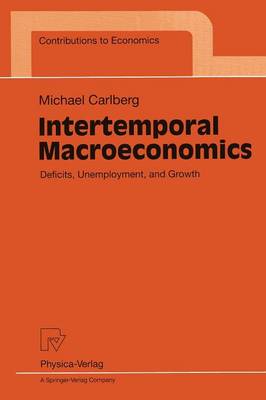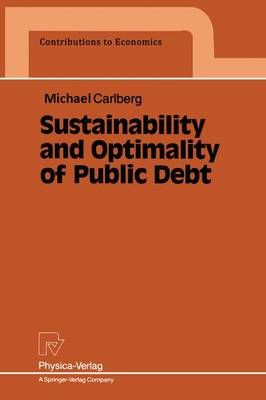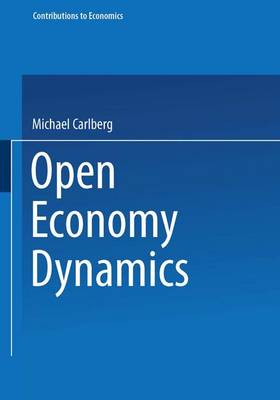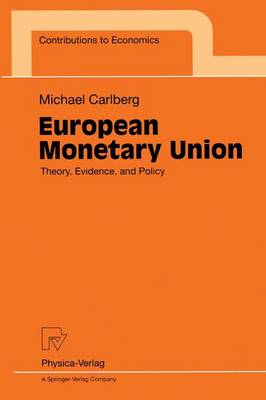Contributions to Economics
5 total works
We live in a world where capital is free to move. Increasingly this determines the pattern of international growth. Savings are invested in the country yielding the highest return, thus adding to its stock of capital. This development is espe- cially true of common markets such as the European Union, which are based on free trade and financial openness. The present monograph deals with internatio- nal growth, featuring the dynamics of foreign debt and domestic capital. I had many helpful talks with my colleagues at Hamburg: Michael Schmid (now at Bamberg), Franco Reither, Wolf Schlifer, Thomas Straubhaar and Johannes Hackmann. In addition, Michael Brauninger and Philipp Lichtenauer carefully discussed with me all parts of the manuscript. Last but not least, Doris Ehrich did the secretarial work as excellently as ever. I wish to thank all of them. Contents INTRODUCTION 3 BRIEF SURVEY OF THE LITERATURE 9 SMALL OPEN ECONOMY 15 CHAPTER I. 1. Solow Model 15 1.1. Foreign Assets 15 1.1.1. Steady State 15 Process of Adjustment 25 1.1.2.
This book is concerned with the long-run effects of budgetary and financial policy on aggregate demand and supply. Here the long run is characterized by the accumulation of public debt and foreign assets. This gives rise to a number of questions. Will the long-run equilibrium be stable? What does long-run instabi- lity imply? Is the long-run multiplier smaller than the short-run multiplier? Can the long-run multiplier become negative? This book takes a new approach to macroeconomic policy. It assumes a growing economy, as opposed to a sta- tionary economy. And it assumes that the government fixes the deficit rate, as opposed to the tax rate. It is argued that economic growth is an important factor of long-run stability. Similarly, it is argued that a fixed deficit rate is an important factor of long-run stability. Previous versions of some parts were presented at the Conference on Money, Banking and Insurance, at the Annual Congress of the European Economic As- at the Annual Conference sociation, at the Symposium on Operations Research, of the Royal Economic Society, at the Jahrestagung des Vereins fUr Socialpolitik and at the Conference on Dynamic Disequilibrium Modelling.
I have benefited from comments by Friedel Bolle, Giuseppe De Arcangelis, Giancarlo Gandolfo, Ulrich Geiger, Alfred Maufiner, Jochen Michaelis, Wolfgang J. Miickl, M. J. M. Neumann, Daphni-Marina Papadopoulou, Franco Reither, Karlhans Sauernheimer, Michael Schmid, Paul Bernd Spahn, Hans-Werner Sinn, Torsten Tewes, G. F. T. Wolswijk and Jiirgen Wolters.
I have benefited from comments by Friedel Bolle, Giuseppe De Arcangelis, Giancarlo Gandolfo, Ulrich Geiger, Alfred Maufiner, Jochen Michaelis, Wolfgang J. Miickl, M. J. M. Neumann, Daphni-Marina Papadopoulou, Franco Reither, Karlhans Sauernheimer, Michael Schmid, Paul Bernd Spahn, Hans-Werner Sinn, Torsten Tewes, G. F. T. Wolswijk and Jiirgen Wolters.
The focus of this book is on the dynamics of public dept. It proves useful to consider the Solow growth model, the overlapping generations model and the infinite horizon model. Sustainability refers to the existence and the stability of the long-run equilibrium. The government can follow either of two strategies: it fixes the deficit ratio or the tax rate. By means of phase diagrams, we trace out the processes of adjustment induced by various macroeconomic shocks. In addition, different scenarios are reviewed: closed economy, the open economy, and two countries. The open economy adds the dynamics of the current account and of foreign dept.
The focus is on the inter action between demand and supply in a small open economy featuring the dynamics of private capital, public debt and foreign assets. The overlapping generations model serves as a microfoundation. It proves useful to consider different scenarios. Exchange rates are either flexible or fixed. Money wages can be flexible, fixed or slow. Monetary and fiscal policy may be exogenous or endo genous. Either budget deficits are allowed, or continuous budget balance is postula ted. Wh at are the implications of various shocks? How does the chain of cause and effect look like? I had many helpful talks with my colleagues at Hamburg: Michael Schmid (now at Bamberg), Wolf Schafer and Johannes Hackmann. In addition, Daphni-Marina Papadopoulou and Christine Schafer-Lochte carefully discussed with me all parts of the manuscript. Last but not least, Doris Ehrich typed the manuscript as excellently as ever. I would like to thank all of them. CONTENTS INTRODUCTION 3 PART 1. FLEXIBLE EXCHANGE RATES 11 CHAPTER 1. BASIC MODEL 11 1. Flexible Money Wages 13 13 1. 1. Overlapping Generations 1. 2. Short-Run Equilibrium and Long-Run Equilibrium 23 1. 3. Stability 27 1. 4. Shoeks 30 2. Fixed Money Wages 34 34 2. 1. Overlapping Generations 2. 2. Short-Run Equilibrium and Long-Run Equilibrium 39 2. 3. Stability 41 2. 4. Shoeks 44 3. Slow Money Wages 52 3. 1. Special Case 1= 0 52 3. 2. General Case 60 4. Monetary Poliey 64 4. 1.
This book explores the new macroeconomics of the European Monetary Union. It carefully discusses the effects of shocks and policy measures on em ployment, prices, and the current account. Take for instance a shock or a policy measure in a specific union country. Then what will be the results in the specific country, in the other union countries, and in the rest of the world? The targets of economic policy are full employment and price stability in each of the union of economic policy are monetary policy by the Euro countries. The instruments pean Central Bank and fiscal policies by national governments. What is the appropriate policy mix? A salient feature of this book is the numerical estimation of shock and policy multipliers. Money wages are fixed, flexible or downward rigid. The monetary union can be small or large. I had many helpful talks with Gerd Focke, Daphni-Marina Papadopoulou, Franco Reither, Wolf Schafer, Christine Schafer-Lochte, and Michael Schmid. In addition, Michael Brauninger and Michael Cyrus carefully discussed with me all parts of the manuscript. Last but not least, Doris Ehrich did the secretarial work as excellently as ever. I wish to thank all of them. Executive Summary 1) Small monetary union of two identical countries, say Gennany and France. The monetary union is a small open economy with perfect capital mobili ty. Let us begin with fiscal policy.
